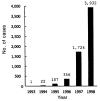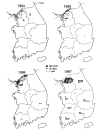Re-emerging Plasmodium vivax malaria in the Republic of Korea
- PMID: 10507220
- PMCID: PMC2733142
- DOI: 10.3347/kjp.1999.37.3.129
Re-emerging Plasmodium vivax malaria in the Republic of Korea
Abstract
Plasmodium vivax malaria, which was highly prevalent in the Republic of Korea, disappeared rapidly since 1970s. However, malaria re-emerged with the first occurrence of a patient in 1993 near the demilitarized zone (DMZ), the border between South Korea and North Korea. Thereafter, the number of cases increased exponentially year after year, totaling 6,142 cases (6,249 if United States Army personnels were included) by the end of 1998. Interestingly enough, the majority of cases (3,743; 61%) was soldiers aged 20-25, camping around the northern parts of Kyonggi-do or Gangwon-do (Province) just facing the DMZ. Among 2,399 civilian cases, 1,144 (47.7%) were those who have recently retired from their military services in the northern parts of the two Provinces. The re-emerging malaria characteristically revealed a combination type of short and long incubation periods with predominance of the long type. The course of illness was relatively mild, and the treatment was successful in most patients. Vector mosquitoes are Anopheles sinensis and possibly A. yatsushiroensis. Wide-scale preventive and control measures should be operated to eradicate this re-emerging disease. It has been suggested by many authors that the initial source of the re-emerging malaria was infected mosquitoes which had flown from the northern part of the DMZ.
Figures







References
-
- Ahn MH, Shin HJ, Im KI, Soh CT. Imported malaria cases in Korea. Yonsei Rep Trop Med. 1982;13:23–29.
-
- Chadee DD, Maitre AL, Tilluckdharry CC. An outbreak of Plasmodium vivax malaria in Trinidad, W.I. Ann Trop Med Parasitol. 1992;86:583–590. - PubMed
-
- Chai IH, Lim GI, Yoon SN, Oh WI, Kim SJ, Chai JY. Occurrence of tertian malaria in a male patient who has never been abroad. Korean J Parasitol. 1994;32:195–200. (in Korean) - PubMed
-
- Chai JY. Proceed of CME Sem on Infec Dis, Korean Soc of Infec Dis. 1996. Re-emergence of malaria; pp. 109–117. (in Korean)
-
- Chai JY. Re-emerging malaria. J Korean Med Ass. 1997;40:728–733. (in Korean)
Publication types
MeSH terms
LinkOut - more resources
Full Text Sources

